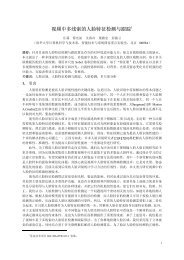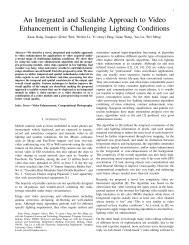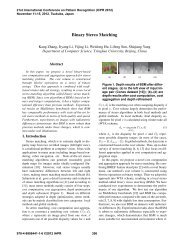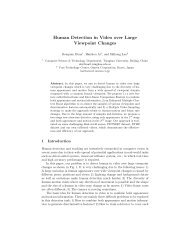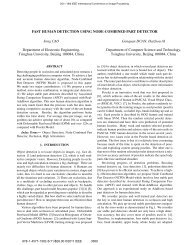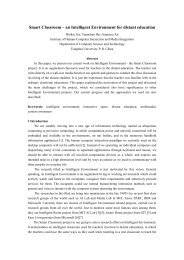An Efficient and Integrated Algorithm for Video Enhancement in ...
An Efficient and Integrated Algorithm for Video Enhancement in ...
An Efficient and Integrated Algorithm for Video Enhancement in ...
You also want an ePaper? Increase the reach of your titles
YUMPU automatically turns print PDFs into web optimized ePapers that Google loves.
1<br />
<strong>An</strong> <strong>Efficient</strong> <strong>and</strong> <strong>Integrated</strong> <strong>Algorithm</strong> <strong>for</strong> <strong>Video</strong><br />
<strong>Enhancement</strong> <strong>in</strong> Challeng<strong>in</strong>g Light<strong>in</strong>g Conditions<br />
Xuan Dong, Jiangtao (Gene) Wen, Senior Member, IEEE, Weix<strong>in</strong> Li, Yi (Amy) Pang, Guan Wang<br />
arXiv:1102.3328v1 [cs.GR] 16 Feb 2011<br />
Abstract—We describe a novel <strong>in</strong>tegrated algorithm <strong>for</strong> realtime<br />
enhancement of video acquired under challeng<strong>in</strong>g light<strong>in</strong>g<br />
conditions. Such conditions <strong>in</strong>clude low light<strong>in</strong>g, haze, <strong>and</strong> high<br />
dynamic range situations. The algorithm automatically detects the<br />
dom<strong>in</strong>ate source of impairment, then depend<strong>in</strong>g on whether it is low<br />
light<strong>in</strong>g, haze or others, a correspond<strong>in</strong>g pre-process<strong>in</strong>g is applied<br />
to the <strong>in</strong>put video, followed by the core enhancement algorithm.<br />
Temporal <strong>and</strong> spatial redundancies <strong>in</strong> the video <strong>in</strong>put are utilized to<br />
facilitate real-time process<strong>in</strong>g <strong>and</strong> to improve temporal <strong>and</strong> spatial<br />
consistency of the output. The proposed algorithm can be used as<br />
an <strong>in</strong>dependent module, or be <strong>in</strong>tegrated <strong>in</strong> either a video encoder<br />
or a video decoder <strong>for</strong> further optimizations.<br />
I. INTRODUCTION<br />
As video surveillance equipments <strong>and</strong> mobile devices such<br />
as digital cameras, smart phones <strong>and</strong> netbooks are <strong>in</strong>creas<strong>in</strong>gly<br />
widely deployed, cameras are expected to acquire, record <strong>and</strong><br />
sometimes compress <strong>and</strong> transmit video content <strong>in</strong> all light<strong>in</strong>g<br />
<strong>and</strong> weather conditions. The majority of cameras, however, are<br />
not specifically designed to be all-purpose <strong>and</strong> weather-proof,<br />
render<strong>in</strong>g the video footage unusable <strong>for</strong> critical applications<br />
under many circumstances.<br />
Image <strong>and</strong> video process<strong>in</strong>g <strong>and</strong> enhancement <strong>in</strong>clud<strong>in</strong>g<br />
gamma correction, de-haz<strong>in</strong>g, de-blur<strong>in</strong>g <strong>and</strong> etc. are wellstudied<br />
areas with many successful algorithms proposed over<br />
the years. Although different algorithms per<strong>for</strong>m well <strong>for</strong><br />
different light<strong>in</strong>g impairments, they often require tedious <strong>and</strong><br />
sometimes manual <strong>in</strong>put-dependent f<strong>in</strong>e-tun<strong>in</strong>g of algorithm<br />
parameters. In addition, different specific types of impairments<br />
often require different specific algorithms.<br />
Take the enhancement of videos acquired under low light<strong>in</strong>g<br />
conditions as an example. To mitigate the problem, far <strong>and</strong><br />
near <strong>in</strong>frared based techniques ([1], [2], [3], [4]) are used <strong>in</strong><br />
many systems, <strong>and</strong> at the same time, various image process<strong>in</strong>g<br />
based approaches have also been proposed. Although far <strong>and</strong><br />
near <strong>in</strong>frared systems are useful <strong>for</strong> detect<strong>in</strong>g objects such<br />
as pedestrians <strong>and</strong> animals <strong>in</strong> low light<strong>in</strong>g environments,<br />
especially <strong>in</strong> “professional” video surveillance systems, they<br />
suffer from the common disadvantage that detectable objects<br />
must have a temperature that is higher than their surround<strong>in</strong>gs.<br />
In many cases where the critical object has a temperature<br />
similar to its surround<strong>in</strong>gs, e.g. a big hole <strong>in</strong> the road, the<br />
<strong>in</strong>frared systems are not as helpful. Furthermore, <strong>in</strong>frared<br />
Xuan Dong, Jiangtao (Gene) Wen <strong>and</strong> Yi (Amy) Pang are with the<br />
Computer Science Department, Ts<strong>in</strong>ghua University, Beij<strong>in</strong>g, Ch<strong>in</strong>a, 100084.<br />
Weix<strong>in</strong> Li <strong>and</strong> Guan Wang are with the School of Computer Science <strong>and</strong><br />
Eng<strong>in</strong>eer<strong>in</strong>g, Beihang University, Beij<strong>in</strong>g, Ch<strong>in</strong>a, 100191.<br />
E-mail: jtwen@ts<strong>in</strong>ghua.edu.cn<br />
systems are usually more expensive, harder to ma<strong>in</strong>ta<strong>in</strong>, with<br />
a relatively shorter life-span than conventional systems. They<br />
also <strong>in</strong>troduce extra, <strong>and</strong> often times considerable power<br />
consumption. In many consumer applications such as video<br />
capture <strong>and</strong> communications on smart phones, it is usually<br />
not feasible to deploy <strong>in</strong>frared systems due to such cost<br />
<strong>and</strong> power consumption issues. Conventional low light<strong>in</strong>g<br />
image <strong>and</strong> video process<strong>in</strong>g enhancement algorithms such as<br />
[5] <strong>and</strong> [6] often work by reduc<strong>in</strong>g noise <strong>in</strong> the <strong>in</strong>put low<br />
light<strong>in</strong>g video followed by contrast enhancement techniques<br />
such as tone-mapp<strong>in</strong>g, histogram stretch<strong>in</strong>g <strong>and</strong> equalization,<br />
<strong>and</strong> gamma correction to recover visual <strong>in</strong><strong>for</strong>mation <strong>in</strong> low<br />
light<strong>in</strong>g images <strong>and</strong> videos. Although these algorithms can<br />
lead to very visually pleas<strong>in</strong>g enhancement results, they are<br />
usually too complicated <strong>for</strong> practical real-time applications,<br />
especially on mobile devices. For example, the process<strong>in</strong>g<br />
speed of the algorithm <strong>in</strong> [5] was only 6 fps even with GPU<br />
acceleration. In [6], recover<strong>in</strong>g each s<strong>in</strong>gle image required<br />
more than one m<strong>in</strong>ute.<br />
In this paper, we describe a novel <strong>in</strong>tegrated video enhancement<br />
algorithm applicable to a wide range of <strong>in</strong>put impairments.<br />
It has low computational <strong>and</strong> memory complexities that<br />
are both with<strong>in</strong> the realm of reasonable availability of many<br />
mobile devices. In our system, a low complexity automatic<br />
module first determ<strong>in</strong>es the pre-dom<strong>in</strong>ate source of impairment<br />
<strong>in</strong> the <strong>in</strong>put video. The <strong>in</strong>put is then pre-processed based on<br />
the particular source of impairment, followed by process<strong>in</strong>g<br />
by the core enhancement module. F<strong>in</strong>ally, post-process<strong>in</strong>g is<br />
applied to produce the enhanced output. In addition, spatial<br />
<strong>and</strong> temporal correlations were utilized to improve the speed<br />
of the algorithm <strong>and</strong> visual quality of the output, enabl<strong>in</strong>g<br />
it to be embedded <strong>in</strong>to video encoders or decoders to share<br />
temporal <strong>and</strong> spatial prediction modules <strong>in</strong> the video codec to<br />
further lower complexity.<br />
The paper is organized as the follow<strong>in</strong>g. In Section II,<br />
we present the heuristic evidences that motivated the idea <strong>in</strong><br />
this paper. In Section III, we expla<strong>in</strong> the core enhancement<br />
algorithm <strong>in</strong> detail, while <strong>in</strong> Section IV we describe various<br />
algorithms <strong>for</strong> reduc<strong>in</strong>g the computational <strong>and</strong> memory complexities.<br />
Sections V conta<strong>in</strong>s the experimental results. Given<br />
that <strong>in</strong> real-world applications, the video enhancement module<br />
could be deployed <strong>in</strong> multiple stages of the end to end procedure,<br />
e.g. be<strong>for</strong>e compression <strong>and</strong> transmission/storage, or<br />
after compression <strong>and</strong> transmission/storage but be<strong>for</strong>e decompression,<br />
or after decompression <strong>and</strong> be<strong>for</strong>e the video content<br />
displayed on the monitor, we exam<strong>in</strong>e the complexity <strong>and</strong> RD<br />
tradeoff associated with apply<strong>in</strong>g the proposed algorithm <strong>in</strong><br />
these different steps <strong>in</strong> the experiments. F<strong>in</strong>ally we conclude
2<br />
the paper <strong>and</strong> future works <strong>in</strong> Section VI.<br />
0.25<br />
II. A NOVEL INTEGRATED ALGORITHM FOR VIDEO<br />
ENHANCEMENT<br />
The pecentage of pixels<br />
0.2<br />
0.15<br />
0.1<br />
0.05<br />
0<br />
0−31 32−63 64−95 96−127 128−159 160−191 192−223 224−255<br />
Distribution of haze videos<br />
0.25<br />
Fig. 1. Examples of orig<strong>in</strong>al (Top), <strong>in</strong>verted low light<strong>in</strong>g videos/images<br />
(Middle) <strong>and</strong> haze videos/images (Bottom).<br />
The motivation <strong>for</strong> our algorithm is a key observation that<br />
if we per<strong>for</strong>m a pixel-wise <strong>in</strong>version of low light<strong>in</strong>g videos or<br />
high dynamic range videos, the results look quite similar to<br />
hazy videos. As an illustrative example, we r<strong>and</strong>omly selected<br />
(by Google) <strong>and</strong> captured a total of 100 images <strong>and</strong> video<br />
clips <strong>in</strong> haze, low light<strong>in</strong>g <strong>and</strong> high dynamic range weather<br />
conditions respectively. Some examples are shown <strong>in</strong> Fig. 1.<br />
Here, the “<strong>in</strong>version” operation is simply<br />
R c (x) = 255 − I c (x), (1)<br />
where R c (x) <strong>and</strong> I c (x) are <strong>in</strong>tensities <strong>for</strong> the correspond<strong>in</strong>g<br />
color (RGB) channel c <strong>for</strong> pixel x <strong>in</strong> the <strong>in</strong>put <strong>and</strong> <strong>in</strong>verted<br />
frame respectively.<br />
As can be clearly seen from Fig. 1, at least visually, the<br />
video <strong>in</strong> hazy weather are similar to the <strong>in</strong>verted output<br />
of videos captured <strong>in</strong> low light<strong>in</strong>g <strong>and</strong> high dynamic range<br />
conditions. This is <strong>in</strong>tuitive because as illustrated <strong>in</strong> [7], <strong>in</strong><br />
all these cases, e.g. hazy videos <strong>and</strong> low light<strong>in</strong>g videos, light<br />
captured by the camera is blended with the airlight (ambient<br />
light reflected <strong>in</strong>to the l<strong>in</strong>e of sight by atmospheric particles).<br />
The only difference is the actual brightness of the airlight,<br />
white <strong>in</strong> the case of haze videos, black <strong>in</strong> the case of low<br />
light<strong>in</strong>g <strong>and</strong> high dynamic range videos.<br />
The observation is confirmed by various haze detection<br />
algorithms. We implemented haze detection us<strong>in</strong>g the HVS<br />
threshold range based method [8], the Dark Object Subtraction<br />
(DOS) approach [9], <strong>and</strong> the spatial frequency based technique<br />
[10], <strong>and</strong> found that hazy, <strong>in</strong>verted low light<strong>in</strong>g videos <strong>and</strong><br />
<strong>in</strong>verted high dynamic range videos were all classified as hazy<br />
video clips, as opposed to “normal” clips.<br />
We also per<strong>for</strong>med the chi-square test to exam<strong>in</strong>e the<br />
statistical similarities between hazy videos <strong>and</strong> <strong>in</strong>verted low<br />
light<strong>in</strong>g <strong>and</strong> high dynamic range videos. The chi-square test is<br />
a st<strong>and</strong>ard statistical tool widely used to determ<strong>in</strong>e if observed<br />
data are consistent with a specific hypothesis. As expla<strong>in</strong>ed <strong>in</strong><br />
[11], <strong>in</strong> chi-square tests, a p value is calculated, <strong>and</strong> usually,<br />
The pecentage of pixels<br />
The pecentage of pixels<br />
0.2<br />
0.15<br />
0.1<br />
0.05<br />
0.25<br />
0.2<br />
0.15<br />
0.1<br />
0.05<br />
0<br />
0<br />
0−31 32−63 64−95 96−127 128−159 160−191 192−223 224−255<br />
Distribution of low light<strong>in</strong>g videos<br />
0−31 32−63 64−95 96−127 128−159 160−191 192−223 224−255<br />
Distribution of high dynamic range videos<br />
Fig. 2. The histogram of the m<strong>in</strong>imum <strong>in</strong>tensity of each pixel’s three color<br />
channels of haze videos (Top), low light<strong>in</strong>g videos (Middle) <strong>and</strong> high dynamic<br />
range videos (Bottom).<br />
if p > 0.05, it is reasonable to assume that the deviation of<br />
the observed data from the expectation is due to chance alone.<br />
In our experiments, the expected distribution was calculated<br />
from hazy videos <strong>and</strong> the observed statistics from <strong>in</strong>verted low<br />
light<strong>in</strong>g <strong>and</strong> high dynamic range videos were tested. In the<br />
experiments, we divided the range [0, 255] of color channel<br />
<strong>in</strong>tensities <strong>in</strong>to eight equal <strong>in</strong>tervals, correspond<strong>in</strong>g to a degree<br />
of freedom of 7. Accord<strong>in</strong>g to the chi-square distribution<br />
table, if we adopt the common st<strong>and</strong>ard of p > 0.05, the<br />
correspond<strong>in</strong>g upper threshold <strong>for</strong> the chi-square value should<br />
be 14.07. The histogram of the m<strong>in</strong>imum <strong>in</strong>tensities of all color<br />
channels of all pixels <strong>for</strong> hazy videos, <strong>in</strong>verted low light<strong>in</strong>g<br />
<strong>and</strong> <strong>in</strong>verted high dynamic range videos were used <strong>in</strong> the tests,<br />
some examples are shown <strong>in</strong> Fig. 2. The results of the chi-
3<br />
TABLE I<br />
RESULTS OF CHI SQUARE TESTS<br />
Data of chi square test Degrees of Freedom Chi square values<br />
Haze videos <strong>and</strong> <strong>in</strong>verted low light<strong>in</strong>g videos 7 13.21<br />
Haze videos <strong>and</strong> <strong>in</strong>verted high dynamic range videos 7 11.53<br />
Fig. 3. Examples of hazy videos/images (Left) <strong>and</strong> their dark channel images<br />
(Right).<br />
Fig. 5. Examples of high dynamic range videos/images (Left) <strong>and</strong> their dark<br />
channel images (Right).<br />
Fig. 4. Examples of low light<strong>in</strong>g videos/images (Left) <strong>and</strong> their dark channel<br />
images (Right).<br />
square tests are given <strong>in</strong> Table I. As can be seen from the table,<br />
the chi-square values are far smaller than 14.07, demonstrat<strong>in</strong>g<br />
that our hypothesis of the similarities between haze videos <strong>and</strong><br />
<strong>in</strong>verted low light<strong>in</strong>g videos, <strong>and</strong> between haze videos <strong>and</strong> high<br />
dynamic range videos is reasonable.<br />
Through the experiments, we also found that the pixels<br />
whose m<strong>in</strong>imum <strong>in</strong>tensity of the three color channels was<br />
low had a very high probability of locat<strong>in</strong>g <strong>in</strong> regions of<br />
houses, vehicles <strong>and</strong> etc.. We <strong>in</strong>troduce the concept of Region<br />
of Interests (ROIs) <strong>for</strong> these regions. To visually demonstrate<br />
the ROIs, we calculated the image of m<strong>in</strong>imum <strong>in</strong>tensities of<br />
color channels <strong>for</strong> hazy videos, <strong>in</strong>verted low light<strong>in</strong>g videos<br />
<strong>and</strong> <strong>in</strong>verted high dynamic range videos. Three examples are<br />
shown <strong>in</strong> Fig. 3, Fig. 4 <strong>and</strong> Fig. 5.<br />
In conclusion, through visual observation <strong>and</strong> statistical<br />
tests, we found that video captured <strong>in</strong> a number of challeng<strong>in</strong>g<br />
light<strong>in</strong>g conditions is statistically <strong>and</strong> visually similar to hazy<br />
videos. There<strong>for</strong>e, it is conceivable that a generic core module<br />
could be used <strong>for</strong> the enhancement of all these cases.<br />
III. A GENERIC VIDEO ENHANCEMENT ALGORITHM<br />
BASED ON IMAGE DE-HAZING<br />
A. Core De-Haz<strong>in</strong>g Based <strong>Enhancement</strong> Module<br />
S<strong>in</strong>ce after proper pre-process<strong>in</strong>g, videos captured <strong>in</strong> challeng<strong>in</strong>g<br />
light<strong>in</strong>g conditions, e.g. low light<strong>in</strong>g <strong>and</strong> high dynamic<br />
range, exhibit strong similarities with hazy videos <strong>in</strong> both the<br />
visual <strong>and</strong> statistical doma<strong>in</strong>s, the core enhancement algorithm<br />
<strong>in</strong> our proposed system is an improved de-haz<strong>in</strong>g algorithm<br />
based on [12].<br />
As mentioned above, most of the exist<strong>in</strong>g advanced hazeremoval<br />
algorithms ([13], [12], [14], <strong>and</strong> [15]) are based on<br />
the well-known degradation model proposed by Koschmieder<br />
<strong>in</strong> 1924 [7]:<br />
R(x) = J(x)t(x) + A(1 − t(x)), (2)<br />
where A is the global airlight, R(x) is the <strong>in</strong>tensity of pixel<br />
x that the camera captures, J(x) is the <strong>in</strong>tensity of the<br />
orig<strong>in</strong>al objects or scene, <strong>and</strong> t(x) is the medium transmission<br />
function describ<strong>in</strong>g the percentage of the light emitted from the<br />
objects or scene that reaches the camera. This model assumes<br />
that each degraded pixel is a comb<strong>in</strong>ation of the airlight<br />
<strong>and</strong> the unknown surface radiance. The medium transmission<br />
describes what percentage of the light emitted from the objects<br />
or scene can reach the camera. <strong>An</strong>d it is determ<strong>in</strong>ed by the<br />
scene depth <strong>and</strong> the scatter<strong>in</strong>g coefficient of the atmosphere.<br />
For the same video where the scatter<strong>in</strong>g coefficient of the<br />
atmosphere is constant, the light is more heavily affected by<br />
the airlight <strong>in</strong> sky regions because of the longer distance. In<br />
other regions such as vehicles, houses <strong>and</strong> etc., especially those<br />
nearby, the light is less affected by the airlight.<br />
The critical part of all the algorithms based on the<br />
Koschmieder model is to estimate A <strong>and</strong> t(x) from the recoded<br />
image <strong>in</strong>tensity I(x) so as to recover the J(x) from I(x). For<br />
example, <strong>in</strong> [13], Independent Component <strong>An</strong>alysis is used to<br />
estimate the medium transmission <strong>and</strong> the airlight. In [12], the<br />
medium transmission <strong>and</strong> airlight are estimated by the Dark<br />
Channel method, based on the assumption that the medium<br />
transmission <strong>in</strong> a local patch is constant.<br />
In our system, we estimate t(x) accord<strong>in</strong>g to [12] us<strong>in</strong>g<br />
t(x) = 1 − ω<br />
m<strong>in</strong><br />
c∈{r,g,b}<br />
{<br />
m<strong>in</strong><br />
y∈Ω(x)<br />
R c }<br />
(y)<br />
A c , (3)<br />
where ω = 0.8 <strong>and</strong> Ω(x) is a local 9 × 9 block centered<br />
at x <strong>in</strong> this paper. As our system also targets application
4<br />
Fig. 6. Examples of process<strong>in</strong>g steps of low light<strong>in</strong>g enhancement algorithm:<br />
<strong>in</strong>put image I (Top left), <strong>in</strong>verted <strong>in</strong>put image R (Top right), haze removal<br />
result J of the image R (Bottom left), <strong>and</strong> output image (Bottom right).<br />
<strong>in</strong> mobile devices, the cpu-<strong>and</strong>-memory-costly soft matt<strong>in</strong>g<br />
method proposed <strong>in</strong> [12] is not implemented <strong>in</strong> our algorithm.<br />
To estimate airlight, we first note that the schemes <strong>in</strong><br />
exist<strong>in</strong>g image haze removal algorithms are usually not robust<br />
<strong>and</strong> even very small changes to the airlight value might lead<br />
to very large changes to the recovered images or video frames.<br />
There<strong>for</strong>e, calculat<strong>in</strong>g airlight frame-wise not only <strong>in</strong>creases<br />
the overall complexity of the system, but also <strong>in</strong>troduces visual<br />
<strong>in</strong>consistency between frames, thereby creat<strong>in</strong>g annoy<strong>in</strong>g<br />
visual artifacts. Fig. 7 shows an example us<strong>in</strong>g the results of<br />
the algorithm <strong>in</strong> [12]. Notice the difference between the first<br />
<strong>and</strong> fourth frame <strong>in</strong> the middle row.<br />
Based on this observation, we propose to calculate airlight<br />
only once <strong>for</strong> a Group of Pictures (GOP). This is done <strong>for</strong><br />
the first frame of the GOP, then the same value is used <strong>for</strong> all<br />
subsequent frames <strong>in</strong> the same GOP. In the implementation,<br />
we also <strong>in</strong>corporated a scene change detection module so as<br />
to detect sudden changes <strong>in</strong> airlight that are not aligned with<br />
GOP boundaries but merit recalculation.<br />
In our system, to estimate airlight, we first select 100 pixels<br />
whose m<strong>in</strong>imum <strong>in</strong>tensities <strong>in</strong> all color (RGB) channels are the<br />
highest <strong>in</strong> the image. Then from these pixels, we choose the<br />
s<strong>in</strong>gle pixel whose sum of RGB values is the highest. Among<br />
successive GOPs, we refresh the value of airlight us<strong>in</strong>g the<br />
equation<br />
A = A ∗ 0.4 + A t ∗ 0.6, (4)<br />
where A t is the airlight value calculated <strong>in</strong> this GOP, A is the<br />
global airlight value. This can efficiently avoid severe changes<br />
of the global airlight value A, br<strong>in</strong>g<strong>in</strong>g about the excellent<br />
recovered results <strong>and</strong> sav<strong>in</strong>g a large amount of computation at<br />
the same time. Examples of the recovered results are shown<br />
<strong>in</strong> Fig. 7. The first <strong>and</strong> fourth frame <strong>in</strong> the bottom row change<br />
gradually us<strong>in</strong>g our algorithm.<br />
Then, from (2), we can f<strong>in</strong>d<br />
J(x) = R(x) − A<br />
t(x)<br />
+ A. (5)<br />
Although (5) works reasonably well <strong>for</strong> haze removal, through<br />
experiments we found that direct application of equation<br />
(5) might lead to under-enhancement <strong>for</strong> low light<strong>in</strong>g areas<br />
<strong>and</strong> over-enhancement <strong>for</strong> high light<strong>in</strong>g areas when applied<br />
to low light<strong>in</strong>g video enhancement. To further optimize the<br />
calculation of t(x), we focus on enhanc<strong>in</strong>g the ROIs while<br />
avoid process<strong>in</strong>g the background, e.g. sky regions <strong>in</strong> low<br />
light<strong>in</strong>g <strong>and</strong> high dynamic range videos. This not only further<br />
reduces computational complexity, but also improves overall<br />
visual quality. To this end, we adjust t(x) adaptively while<br />
ma<strong>in</strong>ta<strong>in</strong><strong>in</strong>g its spatial cont<strong>in</strong>uity, so that the resulted video<br />
becomes more smooth visually. We <strong>in</strong>troduce a multiplier<br />
P (x) <strong>in</strong>to equation (5), <strong>and</strong> through extensive experiments,<br />
we f<strong>in</strong>d that P (x) can be set as<br />
{<br />
P (x) =<br />
Then (5) becomes<br />
2t (x) 0 < t (x) ≤ 0.5,<br />
−2t 2 (x) + 8 − 3<br />
t(x)<br />
0.5 < t (x) ≤ 1.<br />
J(x) = R(x) − A<br />
P (x)t(x)<br />
(6)<br />
+ A. (7)<br />
The idea beh<strong>in</strong>d (7) is as the follow<strong>in</strong>g. When t(x) is smaller<br />
than 0.5, which means that the correspond<strong>in</strong>g pixel needs<br />
boost<strong>in</strong>g, we assign P (x) a small value to make P (x)t(x)<br />
even smaller so as to <strong>in</strong>crease the RGB <strong>in</strong>tensities of this pixel.<br />
On the other h<strong>and</strong>, when t(x) is greater than 0.5, we refra<strong>in</strong><br />
from overly boost<strong>in</strong>g the correspond<strong>in</strong>g pixel <strong>in</strong>tensity. When<br />
t(x) is close to 1, P (x)t(x) may be larger than 1, result<strong>in</strong>g <strong>in</strong><br />
slight “dull<strong>in</strong>g” of the pixel, so as to make the overall visual<br />
quality more balanced <strong>and</strong> pleasant.<br />
For low light<strong>in</strong>g <strong>and</strong> high dynamic range videos, once J(x)<br />
is recovered, the <strong>in</strong>version operation (1) is per<strong>for</strong>med aga<strong>in</strong><br />
to produce the enhanced videos of the orig<strong>in</strong>al <strong>in</strong>put. This<br />
process is conceptually shown <strong>in</strong> Fig. 6. The improvement<br />
after <strong>in</strong>troduc<strong>in</strong>g P (x) can be seen <strong>in</strong> Fig. 9.<br />
B. Automatic Impairment Source Detection<br />
As mentioned above, we use the generic video enhancement<br />
algorithm of the previous subsection <strong>for</strong> enhanc<strong>in</strong>g video<br />
acquired <strong>in</strong> a number of challeng<strong>in</strong>g light<strong>in</strong>g conditions. In<br />
addition to this core enhancement module, the overall system<br />
also conta<strong>in</strong>s a module <strong>for</strong> automatically detect<strong>in</strong>g the ma<strong>in</strong><br />
source of visual quality degradation to determ<strong>in</strong>e if the preprocess<strong>in</strong>g<br />
by pixel-wise <strong>in</strong>version is required. In the case<br />
when pixel-wise <strong>in</strong>version is required, different pixel wise f<strong>in</strong>e<br />
tun<strong>in</strong>g may also be <strong>in</strong>troduced so that the eventual output after<br />
enhancement is further optimized. The flow diagram <strong>for</strong> this<br />
automatic detection system is shown <strong>in</strong> Fig. 8.<br />
Our detection algorithm is based on the technique <strong>in</strong>troduced<br />
by R. Lim et al. [8]. To reduce complexity, we only<br />
per<strong>for</strong>m the automatic detection <strong>for</strong> the first frame <strong>in</strong> a GOP,<br />
coupled with a scene change detection. The correspond<strong>in</strong>g<br />
algorithm parameters are shown <strong>in</strong> Table II. The test is<br />
conducted <strong>for</strong> each pixel <strong>in</strong> the frame. If the percentage of hazy
5<br />
Fig. 7. The comparison of orig<strong>in</strong>al, haze removal, <strong>and</strong> optimized haze removal video clips. Top: <strong>in</strong>put video sequences. Middle: outputs of image haze<br />
removal algorithm of [12]. Bottom: outputs of haze removal us<strong>in</strong>g our optimized algorithm <strong>in</strong> calculat<strong>in</strong>g airlight.<br />
TABLE II<br />
SPECIFIC PARAMETERS OF THE HAZE DETECTION ALGORITHM.<br />
Color attribute Threshold range<br />
S 0 ∼ 255 0 ∼ 130<br />
V 0 ∼ 255 90 ∼ 240<br />
First frame<br />
The other frames<br />
Fig. 9. Examples of optimiz<strong>in</strong>g low light<strong>in</strong>g <strong>and</strong> high dynamic range<br />
enhancement algorithm by <strong>in</strong>troduc<strong>in</strong>g P (x): Input (Left), output of the<br />
enhancement algorithm without <strong>in</strong>troduc<strong>in</strong>g P (x) (Middle), <strong>and</strong> output of<br />
the enhancement algorithm by <strong>in</strong>troduc<strong>in</strong>g P (x) (Right).<br />
Haze<br />
detection<br />
no<br />
Is haze<br />
Invert<br />
Haze<br />
detection<br />
no<br />
Is haze<br />
Dom<strong>in</strong>ate source<br />
is normal<br />
yes<br />
yes<br />
Dom<strong>in</strong>ate source is<br />
low light<strong>in</strong>g/ high<br />
dynamic range<br />
Dom<strong>in</strong>ate source<br />
is haze<br />
Skip this module<br />
Fig. 8. Flow diagram of the module of determ<strong>in</strong><strong>in</strong>g dom<strong>in</strong>ate source of<br />
impairment.<br />
pixels <strong>in</strong> a picture is higher than 60%, we consider the picture<br />
as a hazy picture. Similarly, if an image is determ<strong>in</strong>ed to be a<br />
hazy picture after <strong>in</strong>version, it is labeled as a low light<strong>in</strong>g<br />
or high dynamic range image, both of which require the<br />
<strong>in</strong>troduction of the multiplier P (x) <strong>in</strong>to the core enhancement<br />
algorithm.<br />
IV. ACCELERATION OF PROPOSED VIDEO<br />
ENHANCEMENT PROCESSING ALGORITHM<br />
The algorithm described <strong>in</strong> Section III is a frame based<br />
approach. Through experimental results, we found that the<br />
calculation of t(x) occupies about 60% of the total computation<br />
time. For real-time <strong>and</strong> low complexity process<strong>in</strong>g<br />
of video <strong>in</strong>puts, it is not desirable to apply the algorithm<br />
of Section III on a frame by frame basis, which not only<br />
has high computational complexity, but also makes the output<br />
results much more sensitive to temporal <strong>and</strong> spatial noise, <strong>and</strong><br />
destroys the temporal <strong>and</strong> spatial consistency of the processed<br />
outputs, thereby lower the overall perceptual quality.<br />
To solve these problems, we notice that the t(x) <strong>and</strong><br />
other model parameters are correlated temporally <strong>and</strong> spatially.<br />
There<strong>for</strong>e, we propose to accelerate the algorithm by<br />
<strong>in</strong>troduc<strong>in</strong>g motion estimation.<br />
Motion estimation/compensation (ME/MC) is a key procedure<br />
of the state-of-the-art video compression st<strong>and</strong>ards. By<br />
match<strong>in</strong>g blocks <strong>in</strong> subsequently encoded frames to f<strong>in</strong>d the<br />
“best” match of a block to be encoded <strong>and</strong> a block of the<br />
same size that has already been encoded <strong>and</strong> then decoded<br />
(referred to as the “reference”), video compression algorithms<br />
use the reference as a prediction of the block to be encoded <strong>and</strong><br />
encodes only the difference (termed the “residual”) between<br />
the reference <strong>and</strong> the block to be encoded, thereby reduc<strong>in</strong>g<br />
the rate that is required to encode the current block to a
6<br />
fidelity level. The process of f<strong>in</strong>d<strong>in</strong>g the best match between<br />
a block to be encoded <strong>and</strong> a block <strong>in</strong> a reference frame is<br />
called “motion estimation”, <strong>and</strong> the “best” match is usually<br />
determ<strong>in</strong>ed by jo<strong>in</strong>tly consider<strong>in</strong>g the rate <strong>and</strong> distortion costs<br />
of the match. If a “best” match block is found, the current<br />
block will be encoded <strong>in</strong> <strong>in</strong>ter mode <strong>and</strong> only the residual will<br />
be encoded. Otherwise, the current block will be encoded <strong>in</strong><br />
<strong>in</strong>tra mode. The most commonly used metric <strong>for</strong> distortion <strong>in</strong><br />
motion estimation is the Sum of Absolute Differences (SAD).<br />
Fig. 11.<br />
Subsampl<strong>in</strong>g pattern of proposed fast SAD algorithm.<br />
10 x 107 Relative difference of t(x)<br />
Quantity<br />
9<br />
8<br />
7<br />
6<br />
5<br />
4<br />
3<br />
2<br />
encod<strong>in</strong>g. To this end, each P frame is divided <strong>in</strong>to nonoverlapp<strong>in</strong>g<br />
16 × 16 blocks, <strong>for</strong> which a motion search us<strong>in</strong>g<br />
the SAD is conducted. A threshold T is def<strong>in</strong>ed <strong>for</strong> the SAD<br />
of blocks: if the SAD is below the threshold which means<br />
a “best” match block is found, the calculation of t(x) <strong>for</strong><br />
the entire MB is skipped. Otherwise, t(x) still needs to be<br />
calculated. In both cases, the values <strong>for</strong> the current frame are<br />
stored <strong>for</strong> possible use <strong>for</strong> the next frame. The flow diagram<br />
is shown <strong>in</strong> Fig. 12. We call this acceleration algorithm as ME<br />
acceleration enhancement algorithm.<br />
1<br />
0<br />
0 0.1 0.2 0.3 0.4 0.5 0.6 0.7 0.8 0.9 1<br />
Fig. 10. Differences of t(x) values between the predicted block’s pixels’<br />
<strong>and</strong> its reference block’s pixels’.<br />
To verify the feasibility of us<strong>in</strong>g temporal block match<strong>in</strong>g<br />
<strong>and</strong> ME to expedite t(x) calculation, we calculated the differences<br />
of t(x) values <strong>for</strong> pixels <strong>in</strong> the predicted <strong>and</strong> reference<br />
blocks. The statistics <strong>in</strong> Fig. 10 shows that the differences are<br />
less than 10% <strong>in</strong> almost all cases. There<strong>for</strong>e, we could utilize<br />
ME/MC to accelerate the computationally <strong>in</strong>tensive calculation<br />
of t(x) <strong>and</strong> only needed to calculate t(x) of a few selective<br />
frames. For the non-critical frames, we used the correspond<strong>in</strong>g<br />
t(x) values of the reference pixels. To reduce the complexity<br />
of the motion estimation process, we used mature fast motion<br />
estimation algorithms e.g. Enhanced Prediction Zonal Search<br />
(EPZS) [16]. When calculat<strong>in</strong>g the SAD, similar to [17] <strong>and</strong><br />
[18], we only utilized a subset of the pixels <strong>in</strong> the current<br />
<strong>and</strong> reference blocks us<strong>in</strong>g the pattern shown <strong>in</strong> Fig. 11. With<br />
this pattern, our calculation “touched” a total of 60 pixels <strong>in</strong><br />
a 16 × 16 block, or roughly 25%. These pixels were located<br />
on either the diagonal or the edges, result<strong>in</strong>g <strong>in</strong> about 75%<br />
reduction <strong>in</strong> SAD calculation when implemented <strong>in</strong> software<br />
on a general purpose processor.<br />
In our implementation, when the proposed algorithm is<br />
deployed prior to video compression or after video decompression,<br />
we first divide the <strong>in</strong>put frames <strong>in</strong>to GOPs. The GOPs<br />
could either conta<strong>in</strong> a fix number of frames, or decided based<br />
on a max GOP size (<strong>in</strong> frames) <strong>and</strong> scene chang<strong>in</strong>g. Each<br />
GOP starts with an Intra coded frame (I frame), <strong>for</strong> which all<br />
t(x) values are calculated. ME is per<strong>for</strong>med <strong>for</strong> the rema<strong>in</strong><strong>in</strong>g<br />
frames (P frames) of the GOP, similar to conventional video<br />
Calculate<br />
airlight A<br />
Calculate<br />
t(x)<br />
Is low light<strong>in</strong>g<br />
no<br />
I frame<br />
Recover<br />
J(x)<br />
Output<br />
yes<br />
Invert<br />
no<br />
P frame<br />
EPZS ME<br />
Is <strong>in</strong>ter-mode<br />
block<br />
Calculate t(x)<br />
of the block<br />
yes<br />
Assign reference<br />
block’s t(x)<br />
Fig. 12. Flow diagram of the core enhancement algorithm with ME<br />
acceleration.<br />
In addition to operat<strong>in</strong>g as a st<strong>and</strong>-along module with<br />
uncompressed pixel <strong>in</strong><strong>for</strong>mation as both the <strong>in</strong>put <strong>and</strong> output,<br />
the ME accelerated enhancement algorithm could also be<br />
<strong>in</strong>tegrated <strong>in</strong>to a video encoder or a video decoder. When the<br />
algorithm is <strong>in</strong>tegrated with a video encoder, the encoder <strong>and</strong><br />
the enhancement can share the ME module. When <strong>in</strong>tegrated<br />
with the decoder, the system has the potential of us<strong>in</strong>g the<br />
motion <strong>in</strong><strong>for</strong>mation conta<strong>in</strong>ed <strong>in</strong> the <strong>in</strong>put video bitstream<br />
directly, <strong>and</strong> thereby by-pass<strong>in</strong>g the entire ME process. Such<br />
<strong>in</strong>tegration will usually lead to a RD loss. The reason <strong>for</strong><br />
this loss is first <strong>and</strong> <strong>for</strong>emost that the ME module <strong>in</strong> the<br />
encoder with which the enhancement module is <strong>in</strong>tegrated or
7<br />
the encoder with which the bitstreams that a decoder with<br />
enhancement decodes may not be optimized <strong>for</strong> f<strong>in</strong>d<strong>in</strong>g the<br />
best matches <strong>in</strong> t(x) values. For example, when the enhancement<br />
module is <strong>in</strong>tegrated with an decoder, it may have<br />
to decode an <strong>in</strong>put bitstream encoded by a low complexity<br />
encoder us<strong>in</strong>g a really small ME range. The traditional SAD<br />
or SAD-plus-rate metrics <strong>for</strong> ME are also not optimal <strong>for</strong> t(x)<br />
match search. However, through extensive experiments with<br />
widely used encoders <strong>and</strong> decoders, we found that such quality<br />
loss were usually small, <strong>and</strong> well-justified by the sav<strong>in</strong>gs <strong>in</strong><br />
computational cost. The flow diagrams of <strong>in</strong>tegrat<strong>in</strong>g the ME<br />
acceleration enhancement algorithm <strong>in</strong>to encoder <strong>and</strong> decoder<br />
are shown <strong>in</strong> Fig. 15 <strong>and</strong> Fig. 16. Some of the comparisons<br />
can be found <strong>in</strong> Section V.<br />
V. EXPERIMENTAL RESULTS<br />
To evaluate the proposed algorithm, a series of experiments<br />
were conducted with a W<strong>in</strong>dows PC (Intel Core 2 Duo<br />
processor runn<strong>in</strong>g at 2.0 GHz with 3G of RAM) <strong>and</strong> an iPhone<br />
4. The resolution of test<strong>in</strong>g videos <strong>in</strong> our experiments was<br />
640 × 480.<br />
Fig. 14. Examples of high dynamic range video enhancement algorithm:<br />
Orig<strong>in</strong>al <strong>in</strong>put (Top), <strong>and</strong> the enhancement result (Bottom).<br />
Fig. 13. Examples of low light<strong>in</strong>g video enhancement algorithm: Orig<strong>in</strong>al<br />
<strong>in</strong>put (Top), <strong>and</strong> the enhancement result (Bottom).<br />
Examples of the enhancement outputs <strong>for</strong> low light<strong>in</strong>g, high<br />
dynamic range <strong>and</strong> hazy videos are shown <strong>in</strong> Fig. 13, Fig. 14<br />
<strong>and</strong> Fig. 17 respectively. As we can see from these figures,<br />
the improvements <strong>in</strong> visibility are obvious. In Fig. 13, the<br />
yellow light from the w<strong>in</strong>dows <strong>and</strong> signs such as “Hobby<br />
Town” <strong>and</strong> other Ch<strong>in</strong>ese characters were recovered <strong>in</strong> correct<br />
color. In Fig. 14, the headlight of the car <strong>in</strong> the orig<strong>in</strong>al <strong>in</strong>put<br />
made letters on the license plate very difficult to read. After<br />
enhancement with our algorithm, the license plate became<br />
much more <strong>in</strong>telligible. The algorithm also worked well <strong>for</strong><br />
video captured <strong>in</strong> hazy, ra<strong>in</strong>y <strong>and</strong> snowy weathers as shown<br />
<strong>in</strong> Fig. 17, Fig. 18 <strong>and</strong> Fig. 19.<br />
In addition, the proposed ME-based acceleration greatly<br />
reduces the complexity of the algorithm with little <strong>in</strong><strong>for</strong>mation<br />
lost. As mentioned above, there are three possible ways of<br />
<strong>in</strong>corporat<strong>in</strong>g ME <strong>in</strong>to the enhancement algorithm, i.e. through<br />
a separate ME module <strong>in</strong> the enhancement system, as well as<br />
utiliz<strong>in</strong>g the ME module <strong>and</strong> <strong>in</strong><strong>for</strong>mation available <strong>in</strong> a video<br />
encoder or decoder. Some example outputs of the frame-wise<br />
enhancement algorithm <strong>and</strong> these three ways of <strong>in</strong>corporat<strong>in</strong>g<br />
ME are shown <strong>in</strong> Fig. 23, with virtually no visual difference.<br />
We also calculated the average RD curves of ten r<strong>and</strong>omly<br />
selected experimental videos us<strong>in</strong>g the three acceleration<br />
methods. The reference was enhancement us<strong>in</strong>g the proposed<br />
frame-wise enhancement algorithm <strong>in</strong> YUV region. The RD<br />
curves of per<strong>for</strong>m<strong>in</strong>g the frame-wise enhancement algorithm<br />
be<strong>for</strong>e encod<strong>in</strong>g or after decod<strong>in</strong>g are shown <strong>in</strong> Fig. 20, while<br />
the results <strong>for</strong> acceleration us<strong>in</strong>g a separate ME module are<br />
given <strong>in</strong> Fig. 21, <strong>and</strong> <strong>in</strong>tegrat<strong>in</strong>g the ME acceleration <strong>in</strong>to<br />
the codec are shown <strong>in</strong> Fig. 22. As the RD curves <strong>in</strong> our<br />
experiments reflect the aggregated outcome of both cod<strong>in</strong>g <strong>and</strong><br />
enhancement, <strong>and</strong> because enhancement was not optimized<br />
<strong>for</strong> PSNR based distortion, the shape of our RD curve looks<br />
different from RD curves <strong>for</strong> video compression systems, even<br />
though distortion as measured <strong>in</strong> PSNR is still a monotonic<br />
function of the rate. First, from the three figures, we f<strong>in</strong>d that <strong>in</strong><br />
general, per<strong>for</strong>m<strong>in</strong>g enhancement be<strong>for</strong>e encod<strong>in</strong>g has better<br />
overall RD per<strong>for</strong>mance. Although enhanc<strong>in</strong>g after decod<strong>in</strong>g<br />
means we can transmit un-enhanced video clips, which usually<br />
hav<strong>in</strong>g lower contrast, less detail <strong>and</strong> are easier to compress,<br />
the reconstructed quality after decoder/enhancement is heavily
8<br />
Fn<br />
(current)<br />
Enhance with<br />
ME acceleration<br />
F_enh<br />
DCT<br />
Quant<br />
ME<br />
F’n-1<br />
(reference)<br />
Motion<br />
compensation<br />
P<br />
F_enh’n-1<br />
(reference)<br />
Vectors <strong>and</strong><br />
headers<br />
F_enh’n<br />
(reconstructed)<br />
IDCT<br />
Rescale<br />
X<br />
Reorder<br />
Entropy<br />
encode<br />
Coded<br />
bitstream<br />
Fig. 15.<br />
Flow diagram of the <strong>in</strong>tegration of encoder <strong>and</strong> ME acceleration enhancement algorithm.<br />
F’n-1<br />
(reference)<br />
Motion<br />
compensation<br />
P<br />
F_enh’n<br />
(reconstructed)<br />
Enhance with<br />
ME acceleration<br />
F’n<br />
(reconstructed)<br />
IDCT<br />
Rescale X<br />
Reorder<br />
Entropy<br />
encode<br />
Coded<br />
bitstream<br />
Vectors <strong>and</strong> headers<br />
Fig. 16.<br />
Flow diagram of the <strong>in</strong>tegration of decoder <strong>and</strong> ME acceleration enhancement algorithm.<br />
affected by the loss of quality dur<strong>in</strong>g the encod<strong>in</strong>g, lead<strong>in</strong>g<br />
to an overall RD per<strong>for</strong>mance loss of 2 dB <strong>for</strong> the cases<br />
<strong>in</strong> the experiments. In addition, <strong>in</strong> Fig. 20, the RD loss of<br />
frame-wise enhancement was due to encod<strong>in</strong>g <strong>and</strong> decod<strong>in</strong>g.<br />
In Fig. 21, the RD loss resulted from ME acceleration <strong>and</strong><br />
encod<strong>in</strong>g/decod<strong>in</strong>g. In Fig. 21, the RD loss resulted from<br />
<strong>in</strong>tegration of ME acceleration algorithm <strong>in</strong>to encoder <strong>and</strong><br />
decoder. Overall however, the RD loss <strong>in</strong>troduced by ME<br />
acceleration <strong>and</strong> <strong>in</strong>tegration was small <strong>in</strong> PSNR terms, <strong>and</strong><br />
not visible subjectively.<br />
We also measured the computational complexity of framewise<br />
enhancement, acceleration with a separate ME module<br />
<strong>and</strong> <strong>in</strong>tegration <strong>in</strong>to an encoder or a decoder. The computational<br />
cost was measured <strong>in</strong> terms of average time spent on<br />
enhancement per frame. For the cases when the enhancement<br />
was <strong>in</strong>tegrated <strong>in</strong>to the codec, we did not count the actual<br />
encod<strong>in</strong>g or decod<strong>in</strong>g time, so as to measure only the enhancement<br />
itself. As shown <strong>in</strong> the Table III, us<strong>in</strong>g a separate<br />
ME module saved about 27.5% time on average compared<br />
with the frame-wise algorithm. On the other h<strong>and</strong>, <strong>in</strong>tegrat<strong>in</strong>g<br />
with the decoder saved 40% time compared with the frame<br />
wise algorithm, while <strong>in</strong>tegrat<strong>in</strong>g with the encoder saved about<br />
77.3%.<br />
VI. CONCLUSIONS<br />
In the paper, we propose a novel fast <strong>and</strong> efficient <strong>in</strong>tegrated<br />
algorithm <strong>for</strong> real-time enhancement of videos acquired under<br />
challeng<strong>in</strong>g light<strong>in</strong>g conditions <strong>in</strong>clud<strong>in</strong>g low light<strong>in</strong>g, bad<br />
weather (hazy, ra<strong>in</strong>y, snowy) <strong>and</strong> high dynamic range conditions.<br />
We show that visually <strong>and</strong> statistically, hazy video<br />
<strong>and</strong> video captured <strong>in</strong> various challeng<strong>in</strong>g light<strong>in</strong>g conditions<br />
are very similar, <strong>and</strong> there<strong>for</strong>e a s<strong>in</strong>gle core enhancement<br />
algorithm can be utilized <strong>in</strong> all cases, along with a proper<br />
pre-process<strong>in</strong>g <strong>and</strong> an automatic impairment source detection<br />
module. We also describe a number of ways of reduc<strong>in</strong>g the<br />
computational complexity of the system while ma<strong>in</strong>ta<strong>in</strong><strong>in</strong>g<br />
good visual quality, <strong>and</strong> the tradeoffs <strong>in</strong>volved when the proposed<br />
system is <strong>in</strong>tegrated <strong>in</strong>to different modules of the video<br />
acquisition, cod<strong>in</strong>g, transmission <strong>and</strong> consumption cha<strong>in</strong>.<br />
Areas of further improvements <strong>in</strong>clude better pre-process<strong>in</strong>g<br />
filters target<strong>in</strong>g specific sources of impairments, improved core<br />
enhancement algorithm, <strong>and</strong> better acceleration techniques.<br />
Also of great importance is a system that can process <strong>in</strong>puts<br />
with compounded impairments (e.g. video of foggy nights,<br />
with both haze <strong>and</strong> low light<strong>in</strong>g).
9<br />
TABLE III<br />
PROCESSING SPEEDS OF PROPOSED ALGORITHMS OVER PC AND IPHONE4<br />
PC/ms per frame iPhone4/ms per frame Time saved<br />
Frame-wise enhancement algorithm 40.1 500.3 N/A<br />
Separate ME acceleration enhancement algorithm 29.3 369 27.5%<br />
Integration of ME acceleration enhancement algorithm <strong>in</strong>to encoder 9.2 107.9 77.3%<br />
Integration of ME acceleration enhancement algorithm <strong>in</strong>to decoder 24.8 302.4 40.0%<br />
Fig. 17. Examples of haze removal algorithm: Orig<strong>in</strong>al <strong>in</strong>put (Top), <strong>and</strong> the<br />
enhancement result (Bottom).<br />
Fig. 18. Examples of ra<strong>in</strong>y video enhancement us<strong>in</strong>g haze removal algorithm:<br />
Orig<strong>in</strong>al <strong>in</strong>put (Top), <strong>and</strong> the enhancement result (Bottom).<br />
VII. ACKNOWLEDGMENTS<br />
The authors wish to thank the SRT students Yao Lu, Wei<br />
Meng, Yuanjie Liu, Huan J<strong>in</strong>g <strong>and</strong> Xuefeng Hu at the Media<br />
Lab of the Department of Computer Science <strong>and</strong> Technology<br />
of Ts<strong>in</strong>ghua University <strong>for</strong> the help they provided to this paper.<br />
REFERENCES<br />
[1] M. Blanco, H. M. Jonathan, <strong>and</strong> T. A. D<strong>in</strong>gus. “Evaluat<strong>in</strong>g New Technologies<br />
to Enhance Night Vision by Look<strong>in</strong>g at Detection <strong>and</strong> Recognition<br />
Distances of Non-Motorists <strong>and</strong> Objects,” <strong>in</strong> Proc. Human Factors <strong>and</strong><br />
Ergonomics Society, M<strong>in</strong>neapolis, MN, Jan. 2001, vol. 5, pp. 1612-1616.<br />
[2] O. Tsimhoni, J. Bärgman, T. M<strong>in</strong>oda, <strong>and</strong> M. J. Flannagan. “Pedestrian<br />
Detection with Near <strong>and</strong> Far Infrared Night Vision <strong>Enhancement</strong>,” Tech.<br />
rep., The University of Michigan, 2004.<br />
[3] L. Tao, H. Ngo, M. Zhang, A. Liv<strong>in</strong>gston, <strong>and</strong> V. Asari. “A Multi-sensor<br />
Image Fusion <strong>and</strong> <strong>Enhancement</strong> System <strong>for</strong> Assist<strong>in</strong>g Drivers <strong>in</strong> Poor<br />
Light<strong>in</strong>g Conditions,” <strong>in</strong> Proc. IEEE Conf. Applied Imagery <strong>and</strong> Pattern<br />
Recognition Workshop, Wash<strong>in</strong>gton, DC, Dec. 2005, pp. 106-113.<br />
[4] H. Ngo, L. Tao, M. Zhang, A. Liv<strong>in</strong>gston, <strong>and</strong> V. Asari. “A Visibility<br />
Improvement System <strong>for</strong> Low Vision Drivers by Nonl<strong>in</strong>ear <strong>Enhancement</strong><br />
of Fused Visible <strong>and</strong> Infrared <strong>Video</strong>,” <strong>in</strong> Proc. IEEE Conf. Computer<br />
Vision <strong>and</strong> Pattern Recognition, San Diego, CA, Jun. 2005, pp.25.<br />
[5] H. Malm, M. Oskarsson, E. Warrant, P. Clarberg, J. Hasselgren, <strong>and</strong><br />
C. Lejd<strong>for</strong>s. “Adaptive <strong>Enhancement</strong> <strong>and</strong> Noise Reduction <strong>in</strong> Very Low<br />
Light-Level <strong>Video</strong>,” <strong>in</strong> Proc. IEEE Int. Conf. Computer Vision, Rio de<br />
Janeiro, Brazil, Oct. 2007, pp. 1-8.<br />
[6] E. P. Bennett, L. McMillan. “<strong>Video</strong> <strong>Enhancement</strong> Us<strong>in</strong>g Per-pixel Virtual<br />
Exposures,” <strong>in</strong> Proc. SIGGRAPH ’05, Los <strong>An</strong>geles, CA, Jul. 2005, pp.<br />
845-852.<br />
[7] Koschmieder. “Theorie der horizontalen sichtweite,” <strong>in</strong> Beitr. Phys. Freien<br />
Atm., vol. 12, pp. 171-181, 1924.<br />
[8] R. Lim, T. Bretschneider. “Autonomous Monitor<strong>in</strong>g of Fire-related Haze<br />
from Space,” <strong>in</strong> Conf. Imag<strong>in</strong>g Science, Systems <strong>and</strong> Technology, Las<br />
Vegas, Nevada, Jun. 2004, pp. 101-105.<br />
[9] C. Song, C. E. Woodcock, K. C. Seto, M. P. Lenney, <strong>and</strong> S. A. Macomber.<br />
“Classification <strong>and</strong> Change Detection Us<strong>in</strong>g L<strong>and</strong>sat TM Data: When <strong>and</strong><br />
How to Correct Atmospheric Effects?” <strong>in</strong> Int. Symposium Remote Sens<strong>in</strong>g<br />
of Environment., vol. 75, no. 2, pp. 230-244, Feb. 2001.<br />
[10] Du Y., Gu<strong>in</strong>dong B., <strong>and</strong> Cihlar J.. “Haze Detection <strong>and</strong> Removal <strong>in</strong><br />
High Resolution Satellite Image with Wavelet <strong>An</strong>alysis,” <strong>in</strong> IEEE Trans.<br />
Geoscience <strong>and</strong> Remote Sens<strong>in</strong>g, vol. 40, no. 1, pp. 210-217, Jan. 2002.<br />
[11] R.A. Fisher, <strong>and</strong> F. Yates. “Statistical Tables <strong>for</strong> Biological, Agricultural<br />
<strong>and</strong> Medical Research,” <strong>in</strong> 6th Ed. Oliver <strong>and</strong> Boyd, Ltd., Ed<strong>in</strong>burgh <strong>and</strong><br />
London, 1963, pp. 10-30.<br />
[12] K. He, J. Sun, <strong>and</strong> X. Tang. “S<strong>in</strong>gle Image Haze Removal Us<strong>in</strong>g<br />
Dark Channel Prior,” <strong>in</strong> Proc. IEEE Conf. Computer Vision <strong>and</strong> Pattern<br />
Recognition, Miami, FL, Jun. 2009, pp. 1956-1963.<br />
[13] R. Fattal. “S<strong>in</strong>gle Image Dehaz<strong>in</strong>g,” <strong>in</strong> Proc. SIGGRAPH ’08, Los<br />
<strong>An</strong>geles, CA, Aug. 2008, pp. 1-9.<br />
[14] R. Tan. “Visibility <strong>in</strong> Bad Weather from A S<strong>in</strong>gle Image,” <strong>in</strong> Proc. IEEE<br />
Conf. Computer Vision <strong>and</strong> Pattern Recognition, <strong>An</strong>chorage, Alaska, Jun.<br />
2008, pp. 1-8.<br />
[15] S. G. Narasimhan, <strong>and</strong> S. K. Nayar. “Chromatic Framework <strong>for</strong> Vision<br />
<strong>in</strong> Bad Weather,” <strong>in</strong> Proc. IEEE Conf. Computer Vision <strong>and</strong> Pattern<br />
Recognition, Hilton Head, SC, Jun. 2000, vol. 1, pp. 1598-1605.<br />
[16] A. M. Tourapis. “Enhanced Predictive Zonal Search <strong>for</strong> S<strong>in</strong>gle <strong>and</strong>
10<br />
38<br />
36<br />
st<strong>and</strong>−alone ME enhancement <strong>in</strong> encoder<br />
st<strong>and</strong>−alone ME enhancement <strong>in</strong> decoder<br />
34<br />
PSNR (db)<br />
32<br />
30<br />
28<br />
26<br />
0 1000 2000 3000 4000 5000 6000 7000 8000 9000 10000<br />
bitrate(kb/s)<br />
Fig. 21. RD per<strong>for</strong>mance of separate ME acceleration enhancement <strong>in</strong><br />
encoder <strong>and</strong> decoder.<br />
Fig. 19. Examples of snowy video enhancement us<strong>in</strong>g haze removal<br />
algorithm: Orig<strong>in</strong>al <strong>in</strong>put (Top), <strong>and</strong> the enhancement result (Bottom).<br />
37<br />
36<br />
35<br />
34<br />
<strong>in</strong>tegration of ME enhancement <strong>in</strong>to encoder<br />
<strong>in</strong>tegration of ME enhancement <strong>in</strong>to decoder<br />
PSNR (db)<br />
40<br />
38<br />
36<br />
34<br />
32<br />
frame−wise enhancement be<strong>for</strong>e encoder<br />
frame−wise enhancement after decoder<br />
PSNR (db)<br />
33<br />
32<br />
31<br />
30<br />
29<br />
28<br />
27<br />
0 1000 2000 3000 4000 5000 6000 7000 8000 9000 10000<br />
bitrate(kb/s)<br />
30<br />
Fig. 22. RD per<strong>for</strong>mance of <strong>in</strong>tegration of ME acceleration enhancement<br />
<strong>in</strong>to encoder <strong>and</strong> decoder.<br />
28<br />
0 1000 2000 3000 4000 5000 6000 7000 8000 9000 10000<br />
bitrate(kb/s)<br />
Fig. 20. RD per<strong>for</strong>mance of frame-wise enhancement <strong>in</strong> encoder <strong>and</strong> decoder.<br />
Multiple Frame Motion Estimation,” <strong>in</strong> Proc. Visual Communications <strong>and</strong><br />
Image Process<strong>in</strong>g, San Jose, CA, Jan. 2002, pp. 1069-1079.<br />
[17] T. Koga, K. I<strong>in</strong>uma, A. Hirano, Y. Iijima, <strong>and</strong> T. Ishiguro.“Motion<br />
Compensated Interframe Cod<strong>in</strong>g <strong>for</strong> <strong>Video</strong> Conferenc<strong>in</strong>g,” <strong>in</strong> Proc. Nut.<br />
Telecommun. Conf., New Orleans, LA, Nov. 1981, pp. G5.3.1-G5.3.5.<br />
[18] B. Girod, <strong>and</strong> K. W. Stuhlmüller. “A Content-Dependent Fast DCT <strong>for</strong><br />
Low Bit-Rate <strong>Video</strong> Cod<strong>in</strong>g,” <strong>in</strong> Proc. IEEE Int. Conf. Image Process.,<br />
Chicago, Ill<strong>in</strong>ois, Oct. 1998, vol. 3, pp. 80-83.<br />
[19] X. Dong, Y. Pang, <strong>and</strong> J. Wen. “Fast <strong>Efficient</strong> <strong>Algorithm</strong> <strong>for</strong> <strong>Enhancement</strong><br />
of Low Light<strong>in</strong>g <strong>Video</strong>,” SIGGRAPH ’10 Poster, Los <strong>An</strong>geles, CA,<br />
Jul. 2010.<br />
[20] X. Dong, Y. Pang, J. Wen, G. Wang, W. Li, Y. Gao, <strong>and</strong> S. Yang. “A<br />
Fast <strong>Efficient</strong> <strong>Algorithm</strong> <strong>for</strong> <strong>Enhancement</strong> of Low Light<strong>in</strong>g <strong>Video</strong>,” <strong>in</strong><br />
Int. Conf. Digital Media <strong>and</strong> Digital Content Management, Chongq<strong>in</strong>g,<br />
Ch<strong>in</strong>a, Dec. 2010.<br />
Fig. 23. Examples of comparisons among the frame-wise algorithm <strong>and</strong> the<br />
three proposed ME acceleration methods: Orig<strong>in</strong>al <strong>in</strong>put (Top left), output<br />
of frame-wise algorithm (Top middle), output of separate ME acceleration<br />
algorithm (Top right), output of <strong>in</strong>tegration of ME acceleration algorithm <strong>in</strong>to<br />
encoder (Bottom left) <strong>and</strong> decoder (Bottom right).



